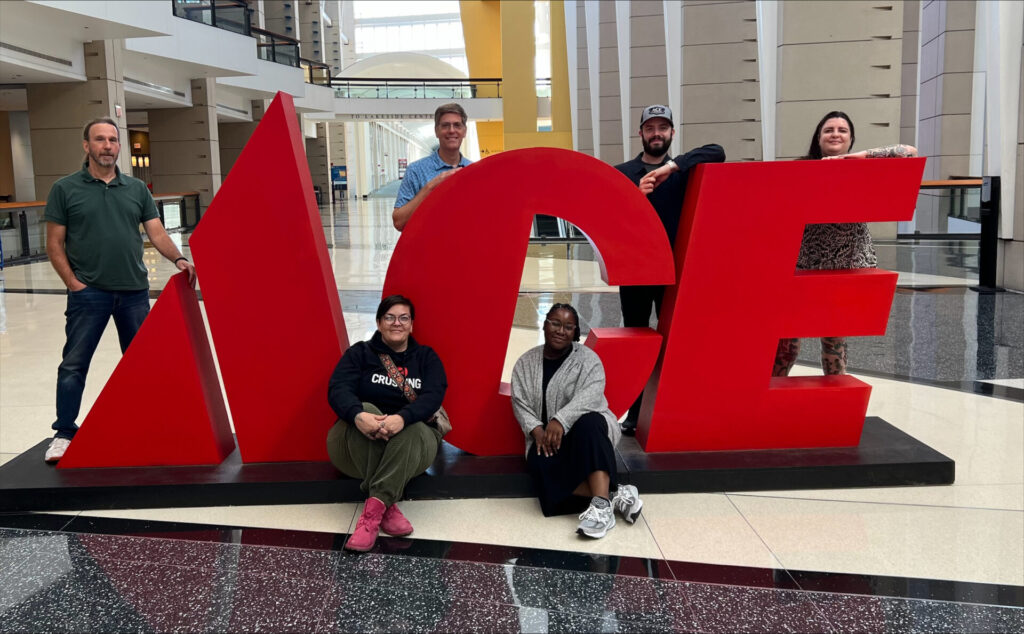In this series of articles, Gina Schaefer writes about her “Big 5” – the metrics her
team uses to track, report on and measure the health of their business.
The best way to determine our success is by knowing what can be improved or even eliminated. And we can’t do that if we’re not constantly taking the pulse of our team.
Metric #3 of the Big 5 is Employee Engagement –
A measurement of the emotional commitment associates have to the store and our goals.
The survey questions and goals are set by our co-op partner, Ace Hardware, and measured on a 5-point scale with 4 points being the base level expectation. However, we are so passionate about maintaining a satisfied team that we upped the ante this year – we increased our goal, and therefore the bonus-worthy metric to 4.25.
There are several easy set-up steps including signing up via a secure portal (the surveys are 100% anonymous), alerting the team two weeks in advance that the exercise is coming, then launching the one-month timeframe for completion.
At multi-store operations like ours, the store managers are in charge of keeping track of who has completed the survey, with a goal of 100% participation. Team members are also given paid time during their shifts to respond to the questions.
Bringing in a member’s voice
To provide an outside perspective, I interviewed Eric Hassett, CEO of Hassett Brother’s Hardware, a third-generation retailer in the bay area of California. As the leader of a successful six-store chain started by his grandfather in 1957, Eric takes employee engagement and culture building very seriously.
I think it’s also worth noting that Eric’s stores operate in an expensive region of the United States – therefore his team has to use all the tools at their disposal to win against high occupancy costs, higher paying jobs and many other factors.
How many times a year do you administer an employee engagement survey?
We make sure that we do at least one employee engagement survey through the Ace program every year but have had occasion to do a second if we see anything culturally that is of concern. If a store scores particularly low in anything, we assess where needs to be improved and reissue the survey several months later.
How do you communicate about the survey to your team?
Survey information is first rolled out via email. We then leverage all of our touch points with employees to encourage their participation, so little reminders of the importance will get sprinkled into our monthly newsletter, they will see a reminder in their Payroll app, and the managers huddle it daily during the open period.
Do you have expected results?
We always expect that if the leadership team is living our core values every day that we will have very strong engagement results from our team, but I never hope for perfect. The best results are always insights into how we can better run our business and take care of our associates.
Are your managers or other leaders bonused on the results?
We do not have any bonuses or incentives for our staff. I believe in paying our team what they are worth and setting the expectations to match. I think the game that is bonuses and incentives is a culture killer.
Do you have a favorite survey question?
My favorite questions always centre around trust. I believe Ace uses “My supervisor, or someone at work seems to care about me as a person.” I always tell our new employees in orientation that we start with trust, we hired them because we believe we can trust them, and that trust is theirs to lose.
What does success look like to you?
Success for me looks like everyone providing open and honest feedback, and most importantly providing commentary and actionable ideas or concerns.
It is very easy in these surveys to take shortcuts – to give a numerical score quickly and move on, usually at the extreme ends of the scale depending on the respondent’s mood or stress level.
While that data has some limited use, the real value comes from the commentary that provides context. For example, some people might give a lower score on communication, because we communicate too much, another because they feel like we don’t communicate enough. Understanding the teams’ preferences is key to developing successful strategies post survey.
Do you share the results with your entire organisation and if so, how?
We share everything with the team. In fact we celebrate them, regardless of the results. We hang all the laundry out for everyone to see.
When we have great results, we share it loudly. When we have a blackeye and need to improve it, we also acknowledge it and detail the steps we are going to take to remedy it.
It is not possible to have accountability in the organisation if it does not start from the top, and as a leader it is my job to make sure I would be happy in any role in my organisation.
Are there ramifications for low scores? How do you handle any if they occur?
If we score poorly in any area, we review what we were doing and create both an action plan and follow up measurements. Those action items go onto our leadership checklist and are reviewed every other week. They stay there until we have the data to say we have solved the concerns.
What do you like or dislike about employee engagement surveys?
Employee engagement surveys can at times cause overreactions and extra work. I always caution my leaders about looking carefully at outliers, sometimes they are not worth pursuing, and sometimes they are the key to a great coaching session that gets the team over a hurdle.
Eric’s final thoughts
I certainly never expected to win an award from Best Places to Work in the San Francisco Bay Area 13 straight years, but I attribute that to our relentless desire to improve and evolve our employee engagement!
An alternative pulse-taker: Stay Interviews
Over the years we’ve used another reporting tool to measure our efficacy called a Stay Interview.
I don’t remember where I first got the idea, but I did not create it myself.
Many companies employ Exit Interviews but these do not occur until the employee is out the door. Sometimes the hope is that they can convince that person to stay, but often it’s to try and glean information about how to make employment better in the future. Unfortunately, at this point it’s too late for the person being interviewed so I’ve often wondered, why bother?

Here is how stay interviews work
- Approximately once a quarter our Director of Human Resources sends out three questions to a select group of employees.
- We keep this selection small – typically less than twenty.
- We use loose criteria such as “employees who have worked here for ten years” to build our list.
- We tell the participants that their answers are NOT anonymous like the engagement surveys. As the CEO (now former), I wanted them to function this way in order to follow up on any comments, suggestions or criticisms that could strengthen our programs.
The Questions
Participants are given five days to respond and are asked the following questions:
- What do you like most about working here?
- What can we do better?
- Why are you still here?
That last question always feels a little cheeky to me, but I like it. I’ve learned over the years that people often stay in a job because they aren’t willing to put in the work to look for a better fit. My hope is that this question prompts them to ponder if they really like where they are with us or if they’ve become complacent.
Once we receive the responses back, I take a look at them to see if I have follow-up questions or action items that can make us stronger.
Eric’s team takes this in a different direction, sending two questions a week to most team members with an emphasis on the new ones. He asks things such as how was their on-boarding experience, what do they wish they had been told, what is the most difficult thing as they started working here, etc.
Gina’s Final Thoughts
Years ago, I read an article about a 5-Star hotel brand that was taking over an existing, less high-end location. The very first thing they did after the purchase was complete was demolish the employee entrance and create a new welcoming space for the team.
They could have started with the lobby or the guest rooms or the hotel bar. But no, they wanted their staff to be proud of where they worked and to understand that the company cared about their luxury too.
The bottom line is this – the happier our team members are, the more likely they are to serve our customers in the manner we want them to be served. And I think what the hotel achieved can be done on any budget with a little creativity.
We are in the midst of this year’s survey goals and I look forward to having an excuse to raise the bar even higher in 2026.
If I can provide any more details, please don’t hesitate to reach out. You can find me gina@ginaschaefer.com or on LinkedIn at Gina Schaefer.

Gina Schaefer, founder of Ace Hardware stores, is a dynamic keynote speaker with nearly 22 years of experience in community-building and business transformation. She grew her business from one to 13 locations, empowering over 130 co-owners. Gina’s engaging talks focus on creating positive corporate cultures, effective succession planning, and empowering women in business. She inspires audiences with her compelling stories and actionable insights, motivating them to drive change and achieve success in both business and life.











